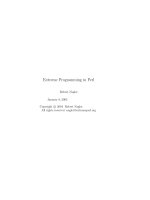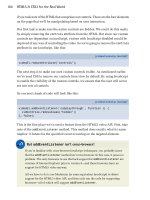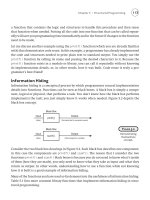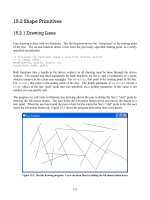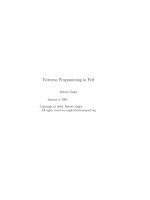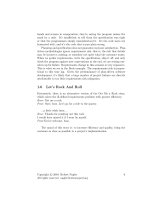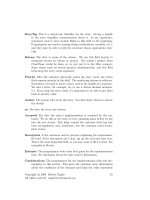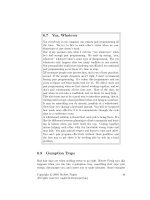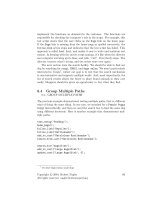Extreme Programming in Perl Robert Nagler phần 5 docx
Bạn đang xem bản rút gọn của tài liệu. Xem và tải ngay bản đầy đủ của tài liệu tại đây (239.85 KB, 16 trang )
implement the functions on demand for the customer. The functions are
responsible for checking the computer’s role in the script. For example, this
test script states that the user clicks on the Dogs link on the home page.
If the Dogs link is missing from the home page or spelled incorrectly, the
follow link action stops and indicates that the test script has failed. This
approach is called fast fail, and makes it easy to write and maintain test
scripts. In keeping with the movie script analogy, it’s like when the director
sees computer screwing up its lines, and yells, “cut!”. Everybody stops. The
director corrects what’s wrong, and the actors start over again.
The next section tests the search facility. We should be able to find our
dog by searching for corgi, CORGI, and dogs wales. We aren’t particularly
interested in Corgis
7
, rather our goal is to test that the search mechanism
is case-insensitive and supports multiple words. And, most importantly, the
list of search results allows the buyer to place found animals in their cart
easily. Shoppers should be given an opportunity to buy what they find.
8.4 Group Multiple Paths
8.4. GROUP MULTIPLE PATHS
The previous example demonstrated testing multiple paths, that is, different
ways of doing the same thing. In one case, we searched for a Female Puppy
Corgi hierarchically, and then we used the search box to find the same dog
using different keywords. Here is another example that demonstrates mul-
tiple paths:
test_setup(’PetShop’);
home_page();
follow_link(’Reptiles’);
follow_link(’Rattlesnake’);
add_to_cart(’Rattleless Rattlesnake’);
remove_from_cart(’Rattleless Rattlesnake’);
search_for(’Angelfish’);
add_to_cart(’Large Angelfish’);
update_cart(’Large Angelfish’, 0);
7
Or other high-energy small dogs.
Copyright
c
2004 Robert Nagler
All rights reserved
60
This example tests the two ways you can remove animals from the cart.
remove from cart uses a button labeled Remove to delete the item from the
cart. update cart allows buyers to change the quantity desired. Setting it
to zero should have the s ame effect as remove from cart.
Most applications allow you to do something in more than one way, like
in this example. Grouping similar functions in the same test is another
organizational technique for your acceptance te st suite. It also provides an
opportunity to talk about an application cross-functionally. The creation of
test scripts is a collaborative effort, much like pair programming. This sort
of detailed matters, and probably won’t come up during the planning game.
The details emerge when the stories and their acceptance tests are being
implemented. The test suite opens a communication channel between the
programmers and the customer to discuss application consistency and other
technical details, such as what to do when the user enters an unexpected
value.
8.5 Without Deviation, Testing Is Incomplete
8.5. WITHOUT DEVIATION, TESTING IS INCOMPLETE
The acceptance test suite also checks that the application handles unex-
pected input gracefully. For example, if the user enters an incorrect login
name, the application should tell the use r not found or something simi-
lar. The technical term for this is deviance testing. It’s like kicking the
tires or slamming the car into reverse while driving on the highway. The
previous examples are conformance tests, because they only validate using
the application for its intended purpose. When you write a deviance test,
you break the rules in order to e nsure the application doesn’t do the wrong
thing, such as displaying a stack trace instead of an error message or allowing
unauthorized access.
For example, here’s how we test login conformance and deviance of the
PetShop:
test_setup(’PetShop’);
home_page();
login_as(’demo’, ’password’);
login_as(’DEMO’, ’password’);
login_as(’’, ’password’);
login_as(’’, ’password’);
Copyright
c
2004 Robert Nagler
All rights reserved
61
test_deviance(’does not match’);
login_as(’demo’, ’PASSWORD’);
test_deviance(’must supply a value’);
login_as(’demo’, ’’);
login_as(’’, ’password’);
test_deviance(’not found’);
login_as(’notuser’, ’password’);
login_as("demo’||’", ’password’);
login_as(’%demo%’, ’password’);
The first section tests conformance. We login as demo and DEMO to test
that user names can be case insensitive. The PetShop allows you to login
with an email address, case insensitively.
Passwords are case sensitive, however. The next section expects the ap-
plication to return an error message that contains does not match when
given a password in the wrong case. This is a deviance test, and the
test deviance that begins the next section tells the test framework that
the subsequent statements should fail and what the expected output should
contain. This is an example where the test script specifies the computer’s
role as well as the user’s.
The application should ask the user to supply a value, if either the login
name or password fields on the form are blank. The next section tests this.
This case might be something a programmer would suggest to the customer.
The customer might decide that must supply a value is too computer-like,
and ask the programmer to change the application to say something like,
Please enter your login ID or email address.
In the last section, we test a variety of not found cases. The first
case assumes that notuser is not a user in the system. The test suite
database is constructed so that this is the case. The last two cases are highly
technical, and are based on the programmer’s knowledge of the application
internals, that is, SQL, a database programming language, is used to find the
user. Some applications do not correctly validate application input, which
can allows the user unauthorized access to system internals. This is how
computer virii and worms work. This test case validates that the user name
is checked by the application before it is used in a low-level SQL statement.
If the user name syntax is not checked by the application, one of the last
two cases might allow the user to login, and the deviance test would fail.
Copyright
c
2004 Robert Nagler
All rights reserved
62
Note that we didn’t test notuser without a password. It’s not likely that
an invalid user could login without a pass word when a valid user couldn’t.
In testing parlance, the two tests are in the same equivalence class. This
means we only need to test one case or the other but not both.
We use equivalence classes to reduce the size of the test suite. A large
application test suite will have thousands of cases and take hours to run.
It’s important to keep the runtime as short as possible to allow for frequent
testing. And, as always, the less code to do what needs to get done, the
better.
8.6 Subject Matter Oriented Programming
8.6. SUBJECT MATTER ORIENTED PROGRAMMING
Another way to minimize test length is letting the problem, also known as
subject matter, guide the development of the functions used by the scripts.
The customer is probably not a programmer. Moreover, the customer’s
terminology has probably been refined to match her subject matter. The
programmers should let the customer choose the function names, and the
order and type of the function parameters. The language she uses is probably
near optimal for the subject and workflow.
The process of bringing the program to the problem is what I call, subject
matter oriented programming (SMOP). It is what XP strives for: creating
an application that speaks the customer’s language. The acceptance test
suite is probably the customer’s most important design artifact, because
it encodes the detailed knowledge of what the application is supposed to
do. If she or her co-workers can’t read the tests, the suite’s value is greatly
diminished.
The design and implementation of the acceptance test suite evolves as
the customer encodes her knowledge. The programmer may need to help the
customer to identify the vocabulary of the subject matter. Subject matter
experts sometimes have difficulty expressing what they do succinctly. The
programmer needs to be part linguist, just like Larry Wall, Perl’s inventor.
Unlike other language designers, Larry lets the problems programmers face
dictate the solution (the programming language) they use. Perl is not pre-
scriptive, in linguistics terms, but descriptive, evolving to meet the language
used by programmers, not the other way around.
Enough theory. I’m in danger of getting lost in the solution myself.
If you are a programmer, you’ll learn how to implement a subject matter
oriented program in the It’s a SMOP chapter. I’ll get back to the customer,
Copyright
c
2004 Robert Nagler
All rights reserved
63
and another method by which she can create the acceptance test suite.
8.7 Data-Driven Testing
8.7. DATA-DRIVEN TESTING
The test examples up to this point have been written in Perl syntax. While
I fully believe just about anybody can follow these simple syntactic conven-
tions, customers may balk at the idea. Ward Cunningham, a well-known
XPer, has taken subject matter oriented programming to a new level. His
framework for intergrated testing (FIT) lets customers write acceptance tests
in their own language using their own tools, office applications, such as, word
processors and spreadsheets. Here’s the login test translated as a FIT doc-
ument:
FIT Login
FIT ignores all text in the document except for tabular text. The tables
contain the text inputs and expected outputs. This allows the customer to
document the tes t, and to have one document which contains many tests.
The order of the columns and what they are for is worked out between the
Copyright
c
2004 Robert Nagler
All rights reserved
64
customer and the programmer. Once that’s done, the framework does the
rest.
8
Just like the Perl examples earlier, the custom er must specify the test
language interpreter, PetShop. In this type of FIT test, the customer e nters
actions (login) on a row-by-row basis. The programmer can create new
actions. The cells to the right of the action name are parameters. The
login action accepts a user name, a pass word, and an error message. If the
there’s no error message, login tests that the login was successful.
The subject matter may suggest a different organization for the tables.
For example, here’s a denser te st format for a simple math module:
9
FIT Math
As with the login test, the first line contains the test language interpreter,
SimpleMath. The next row lists the actions in a columnar format. The first
action sets an x value, the next sets y, and the last two columns test adding
8
Thanks to Brian Ingerson for implementing Test-FIT, and making it available on
CPAN.
9
SimpleMath and the test data were adapted from Test-FIT, version 0.11, on CPAN.
Copyright
c
2004 Robert Nagler
All rights reserved
65
(sum)) and subtracting (diff). The subsequent rows contain a test in each
cell of the table. The first row sets x and y to 1 and 2 and tests that sum
and diff return 3 and -1. As you can see, this kind of FIT test gives
the customer a clear overview of the acceptance test data using an ordinary
word processor. With this style of testing, customers can c reate spreadsheets
using formulas.
The general term for using documents as test inputs is called data-driven
testing. And, sometimes there’s no practical alternative to using tabular
data. On one project we developed, we needed to test the correctness of
a pre-marital evaluation tool. Each partner in a couple had to answer 350
questions. The scoring algorithm related the couple’s answers for compat-
ibility. The customer had supplied us with the questions, answers, scores,
and weights in tabular format. When we asked for acceptance test data,
he simply added the answers for test couples in another column, and we
generated the tes t suite by parsing out the data. As it turned out, the test
data uncovered several areas that were misunderstood by the programmers.
Without customer generated test data, the software would have contained
critical defects.
8.8 Empower The Customer to Test
8.8. EMPOWER THE CUSTOMER TO TEST
Whether the customer uses a spreadsheet, a word processor, or Perl, she can
write tests. And, she needs to. No one else on the team knows the subject
matter better than she does.
Getting started is the hardest part. Take the simplest and most straight-
forward part of the application. Write a test outline for it together on the
whiteboard. Implement that test, and run it together.
After the first steps, you’ll fill in more and more detail. As the suite
grows with the implementation, the application will benefit from the regular
exercise. The programmers will gain deepe r insight into the subject matter.
The customer will see the quality improve firsthand. And, everybody will
benefit from the well-structured knowledge base encoded by your acceptance
test suite.
Copyright
c
2004 Robert Nagler
All rights reserved
66
Chapter 9
Coding Style
Language requires consensus.
– Larry Wall
1
Code is the primary means of communication in an XP team. A uni-
form coding style greatly facilitates code comprehension, refactoring, pair
programming, collective ownership and testing. An XP team agrees on a
coding style before development starts.
Coding style is the first problem and XP team has to work out as a
group. The s olution to the problem needs to be clear and unambiguous. It’s
amazing how far this can be, and with some teams it’s impossible.
Coding style discussions are like a lightning rod. If there’s a storm
brewing within the team, co ding style will usually attract the first lightning
strike. If you can’t reach agreement on a style, your team is going to have
difficulty building an application together.
Tension around style choices is natural in some ways. We are all individ-
uals. Programmers take pride in their own work, further motivating their
own success, just as individual athletes value their own accomplishments.
However, not even the best pitcher, quarterback, or forward in the world
can win a game alone. It takes a team and teamwork to win a game or write
a large application. Programming is a team sport.
2
If you are a programmer, you may find yourself gritting your teeth at
my coding style. It wouldn’t surprise me. Athletes and programmers on
1
Open Sources: Voices from the Open Source Revolution, DiBona et al, 1999, O’Reilly,
p. 127. Available online at />2
And more generally, “Business is a team sport.” Rich Kid, Smart Kid, Kiyosaki et
al, Warner Books, 2001, p. 224-225.
67
different teams sometimes bristle at each other’s style. However, if we were
to join the same team, we’d work out a compromise on coding style to ensure
the success of the project.
This chapter explains the need for a coding style in XP and discusses
how to go about creating one. I also explain and demonstrate the coding
style used in this book through a comparative example.
9.1 There’s More Than One Way To Do It
Perl is a rich and c omplex language. If you ask a question about how to
do some thing in Perl on the Internet, you’ll probably ge t several different
answers. And, the answers will often include the caveat: TMTOWTDI. This
is the acronym for Perl’s motto: There’s more than one way to do it. The
solution you choose will depend on the way you program Perl.
So how do you program Perl? Larry Wall et al present a c oding style in
the perlstyle man page.
3
Yet there are myriad divergent styles on CPAN
and in the Perl literature. In the Perl community, diversity is seen as a
strength, and no one is going to tell you how to program Perl. Well, even if
they did, you wouldn’t listen to them.
9.2 Give Me Consistency or Give Me Death
Your team still nee ds to pick a style. This isn’t just XP dogma; it’s human
nature. In the anthropology classic, The Silent Language, Edward Hall
wrote, “The drive toward congruity would seem to be as strong a human
need as the will to physical survival.” I conclude from this that if you don’t
pick a Perl coding style, you’ll die. If that isn’t a good enough reason, stop
reading now.
Seriously, consistency is not an end in itself, it is the means to facilitate
testing, collective ownership, pair programming, and refactoring. If you are
developing a small application (a few thousand lines of Perl), it’s easy to
keep the code consistent, or to clean it up in an afternoon or two. For large
applications (tens or hundreds of thousands of lines spread over hundreds
or thousands of files), quick fixes are impossible. You would never have the
time to reformat the entire codebase.
The code changes too quickly. You don’t get to ask everybody working
on a large application to stop while you fix some style issue. However, for
3
od/perlstyle.html
Copyright
c
2004 Robert Nagler
All rights reserved
68
some necessary refactorings, such as, a change in a widely used API, you
may have no choice but to dive into tens or possibly hundreds of files. You’ll
want this to happen as quickly as possible so you’ll automate the refactoring.
With a consistent style, you can probably do this fairly easily. If you have
to account for the many ways you can do things in Perl, you’ll probably
resort to hand editing each file. Not only is this labor intensive, but it’s
error prone, too.
Even when you aren’t making global changes, you and your partner still
have to read unfamiliar code. A programming pair’s ability to read and
to communicate through the code is affected directly by its consistency.
Communication is hard e nough without you and your partner having to
wade through several code dialects. And, allowing for style variations when
writing code opens up too many unnecessary thoughts. Do I adapt to my
partner’s style? Should we adopt the style of the code we’re editing now?
Or perhaps, I should insist on my style. After all, it has worked well for me
over the years. Starting out with an agreed upon style, frees our minds of
such distractions and allows us to focus on the important bit: solving the
customer’s problem.
9.3 Team Colors
In Extreme Programming Explained, Kent Beck wrote, “The standard must
be adopted voluntarily by the whole team.” This may not be so simple.
Establishing consensus requires work on everybody’s part. If your team has
coded together before, you’ll probably have an easy time agreeing on a style.
For newly formed teams, use the style guide as a team building exercise.
Everyone should be encouraged to contribute. If a particular point is to o
contentious, drop it until after the first iteration or so. The goal is to get full
consensus on the entire guide. If someone is particularly inflexible during the
discussions, it’s a warning sign that a team adjustment may be necessary.
Better sooner than later.
A style guide can be highly motivating, however. It’s like your team’s
colors. It’s something relatively insignificant which provides significant co-
hesion. If even one team member is coerced into agreement, the team isn’t
sticking together, and the rift may grow into a chasm. When everybody
voluntarily accepts the style choices, you are functioning as a team, and you
are ready to code.
Copyright
c
2004 Robert Nagler
All rights reserved
69
9.4 An Example
Rather than discuss style in the abstract, I’d like to demonstrate my opinion
of good style through a comparative example. Here’s an excerpt from the
popular Test package on CPAN:
4
package Test;
use strict;
sub plan {
croak "Test::plan(%args): odd number of arguments" if @_ & 1;
croak "Test::plan(): should not be called more than once" if $planned;
local($\, $,); # guard against -l and other things that screw with
_reset_globals();
_read_program( (caller)[1] );
my $max=0;
for (my $x=0; $x < @_; $x+=2) {
my ($k,$v) = @_[$x,$x+1];
if ($k =~ /^test(s)?$/) { $max = $v; }
elsif ($k eq ’todo’ or
$k eq ’failok’) { for (@$v) { $todo{$_}=1; }; }
elsif ($k eq ’onfail’) {
ref $v eq ’CODE’ or croak "Test::plan(onfail => $v): must be CODE";
$ONFAIL = $v;
}
else { carp "Test::plan(): skipping unrecognized directive ’$k’" }
}
my @todo = sort { $a <=> $b } keys %todo;
if (@todo) {
print $TESTOUT "1 $max todo ".join(’ ’, @todo).";\n";
} else {
print $TESTOUT "1 $max\n";
}
4
/>Copyright
c
2004 Robert Nagler
All rights reserved
70
++$planned;
print $TESTOUT "# Running under perl version $] for $^O",
(chr(65) eq ’A’) ? "\n" : " in a non-ASCII world\n";
print $TESTOUT "# Win32::BuildNumber ", &Win32::BuildNumber(), "\n"
if defined(&Win32::BuildNumber) and defined &Win32::BuildNumber();
print $TESTOUT "# MacPerl verison $MacPerl::Version\n"
if defined $MacPerl::Version;
printf $TESTOUT
"# Current time local: %s\n# Current time GMT: %s\n",
scalar( gmtime($^T)), scalar(localtime($^T));
print $TESTOUT "# Using Test.pm version $VERSION\n";
# Retval never used:
return undef;
}
The routine plan is used to set up a unit test, for example:
use Test;
use strict;
BEGIN {
plan(tests => 2);
}
ok(1 + 1 == 2);
ok(2 * 2 == 4);
This unit test calls plan to declare that there are two test cases. The
ok function checks the result after each case executes, and prints success or
failure.
Here’s what I think is good about this implementation of plan. The
routine:
• is well-used and mature. We can be relatively s ure it addresses the
needs of its users and is relatively stable.
Copyright
c
2004 Robert Nagler
All rights reserved
71
• has had several authors. The more eyes on a problem, the better the
solution.
• addresses type safety. Test has a broad user base, so it makes sense
to put extra effort into argument validation.
• fails fast, that is, if plan encounters an unexpected argument or state,
it terminates execution (calls croak) in all but one case. The sooner
a programming error is detected, the less damage the errant program
can do.
• is backwards compatible. The parameters test and failok are dep-
recated, that is, they shouldn’t be used in new tests, but existing tests
that use them still work.
• comes with a thorough unit test suite that describes expected behavior
and enables refactoring.
• uses fine-granularity, feature-driven portability. It uses narrow feature
checks (for example, defined $MacPerl::Version and chr(65) eq
’A’)) instead of broad general checks, such as, checking the operating
system (for example, $^0 eq ’MacOS’). Powerful and easy to use in-
trospection is one of the reasons Pe rl and CPAN packages are usable
on so many platforms.
9.5 You Say, “if else”, And I Say, “? :”
While indentation, lining up braces, or other formatting is important to ease
automated refactoring, you won’t find much discussion about them in this
book. However, the more strictly you follow your coding style, the more
easily you can automate refactorings. For example, if function arguments
are always surrounded by parentheses, you can rename functions or reorder
parameters using a simple editor macro.
5
And speaking of editors, most programmers’ editors have style format-
ters. If yours doesn’t, you can always use perltidy, a very flexible Perl code
reformatter.
6
Automatic formatters improve your team’s efficiency and ad-
herence to your style guidelines. That’s all I’m going to say about formatters
5
You can download some refactoring functions for Emacs from
/>6
Available for free from
Copyright
c
2004 Robert Nagler
All rights reserved
72
and editors. The only thing worse than coding style discussions are editor
wars.
Like editors, style choice is defined by your experience and personal taste,
and the details matter. I follow the perlstyle man page for the most part,
but I disagree with some of their parentheses and alignment choices. You
may not like my style, so go ahead and indent by three spaces if you like.
7
9.6 Once And Only Once
Parentheses and indentation aside, the important bit of my style is that I
refactor ruthlessly. I don’t like redundancy, especially in the form of single
use temporary variables and repetitive calls. In XP, we call this the once
and only once (OAOO) rule, and it’s what you do when you refactor.
For new code, I try to do the simplest thing that could possibly work
(DTSTTCPW). This is XP’s most important coding guideline. First I get
it working simply. I might have to copy and paste some code or c reate a
temporary variable. Once it passes the tests, I look at the design and simplify
it so that each concept is expressed once and only once. There are some time
and planning trade offs here, and the Refactoring chapter discusses them.
The relevant point is that once and only once is an overarching style guidline,
and one that I value highly. When concepts are express ed once and only
once, the code is more robust, more easily extensible, and performs better
than code with needless duplication.
9.7 Refactored Example
The code that follows has been changed to demonstrate once and only once
and other style choices I value. The formatting matches the style used in
this bo ok. More imp ortantly, the rewritten code is more cohesive. Not
only should each concept be expressed only once, but each routine should
implement only one concept. Strong cohesion allows people to comprehend
and to abstract code entities (routines and packages) easily. By isolating
and naming each behavior, we make it easy to understand what each piece
of the software puzzle does.
The four new routines are also loosely coupled. This me ans their inputs
and outputs are few and well-defined. Loose coupling is important when
isolating behavior, because it is difficult to understand and to test a routine
7
Even though it’s a sin.
Copyright
c
2004 Robert Nagler
All rights reserved
73
with many inputs and outputs. In effect, the routine’s identity is a combina-
tion of its name and its inputs and outputs, which is commonly know as its
signature. We remember shorter signatures and the behavior they identify
more easily than longer ones.
That’s enough theory for now, here’s the my version of plan:
package Test;
use strict;
sub plan {
my($args) = {@_};
Carp::croak(’should not be called more than once’)
if $_TODO;
_reset_globals();
_read_program((caller)[1]);
_plan_print(_plan_args($args));
return;
}
sub _plan_args {
my($args) = @_;
$_ONFAIL = _plan_arg_assert($args, [’onfail’], ’CODE’);
my($max) = _plan_arg_assert($args, [’tests’, ’test’], ’integer’) || 0;
# $_TODO is the initialization sentinel, so it’s the last value set
$_TODO = {map {$_ => 1}
@{_plan_arg_assert($args, [’todo’, ’failok’], ’ARRAY’) || []}};
Carp::carp("@{[sort(keys(%$args))]}: skipping unrecognized or",
’ deprecated directive(s)’)
if %$args;
return $max;
}
sub _plan_arg_assert {
my($args, $names, $type) = @_;
foreach my $n (@$names) {
next unless exists($args->{$n});
Carp::croak("$n: parameter must not be undef")
unless defined($args->{$n});
Carp::croak("$args->{$n}: $n must be $type")
unless $type eq ’integer’ ? $args->{$n} =~ /^\d+$/
Copyright
c
2004 Robert Nagler
All rights reserved
74
: ref($args->{$n}) eq $type;
return delete($args->{$n})
}
return undef;
}
sub _plan_print {
my($max) = @_;
_print(join("\n# ",
"1 $max"
. (%$_TODO ne ’’ && " todo @{[sort {$a <=> $b} keys(%$_TODO)]};"),
"Running under perl version $] for $^O"
. (chr(65) ne ’A’ && ’ in a non-ASCII world’),
defined(&Win32::BuildNumber) && defined(Win32::BuildNumber())
? ’Win32::BuildNumber ’ . Win32::BuildNumber() : (),
defined($MacPerl::Version)
? "MacPerl version $MacPerl::Version" : (),
’Current time local: ’ . localtime($^T),
’Current time GMT: ’ . gmtime($^T),
"Using Test.pm version $VERSION\n"));
return;
}
sub _print {
local($\, $,);
return print($TESTOUT @_);
}
9.8 Change Log
The following is a detailed list of changes, and why I made them. Most of
the changes are refactorings, that is, they do not modify the way plan works
from the caller’s perspective. A few changes improve the behavior ever so
slightly, and are noted below. This list is ordered from most important to
trivial:
• The four main behaviors: control flow, validating arguments, type
Copyright
c
2004 Robert Nagler
All rights reserved
75
